
|
| |
|
|
|
|
 |
|
|
German SS Camo Uniforms
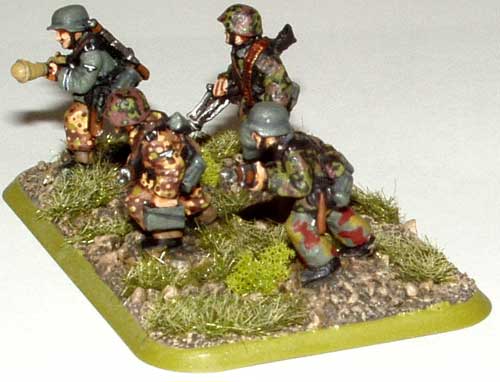 |
Painting German SS Camouflage
– Waffen SS Plane Tree and Oak Leaf
As promised Simon has put together a guide on how to paint German camouflage cloth. In this first part he looks at the Waffen SS Plane Tree and Oak Leaf patterns.
Plane Tree
A Major of an SS reconnaissance section was the first to suggest the Waffen SS be equipped with camouflage clothing.
|
|
This lead to the development and widespread use of camouflage zeltbahns (Tent/Poncho), smocks and helmet covers within the SS. The use of the Wehrmacht’s splinter pattern zeltbahn predates those used by the SS, but I will go further into this pattern in another article.
The earliest clothing was tested in 1937 by a professor who based his studies on the effect of sunlight through trees. The Plane Tree pattern is the earliest used by the SS and can be seen in pre-war photos.
It is a reversible material that has a “spring” green and "autumn" brown side which a soldier can change depending on the surrounding vegetation. Plane Tree camouflage clothing was used up until around 1944.
For Painting Plane Tree camouflage I start with a black undercoat, in fact I start with a black undercoat on all my WWII miniatures as the colours tend to turn out a little bit more drab.
Right: Close-ups of Simons "Spring" Plane Tree camouflage.
|
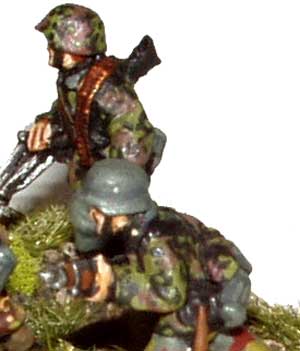 |
 |
The first step is to get the base colour for the camouflage material, as you can see by the photograph of the Plane Tree; the “spring” side uses green to start with and then adds other colours on top. I paint camouflage in the same steps as the material is printed; that way, you get a closer look to the real thing.
Now on to colours. I use GW paints mainly due to the fact that I have easy access to this range and have made up my own colour recipes for consistency. Please experiment with different brands of paint to get the colour to match and let me know what colours you come up with (Particularly Vallejo as I’m just starting to explore this range).
The “spring” side colour scheme starts with a base coat mixture of 50:50 catachan green and camo green. If you look at the photo of the soldier wearing the Plane Tree smock you can see two shades of green. In 15mm scale you would never be able to distinguish between these two shades, so one shade of green is enough.
The next step is to add some random shapes and dots in a 50:50 mixture of scorched brown and graveyard earth.
Once this has dried a third and final colour is added. Officially this should be black, but of all the examples of Plane Tree clothing I’ve seen, the black is always a washed out shade. This time a 50:50 mixture of black and catachan green is added in further random shapes and dots.
To finish the pattern off, using the base colour green, add small dots on top of the black shapes. You should get a pattern like the one in the step-by-step guide and your Plane Tree camouflage is complete.
| Spring Plane Tree |
Vallejo |
| Base Green |
Germ Cam Bright Green VP833 |
| Brown |
Germ Cam Med Brown VP826 |
| Black/Green |
Germ Cam Extr. Dk Green VP896 |
|
|
Oak Leaf
Oak Leaf camouflage was introduced in 1942-43 and followed the same principles of creating a pattern of sunlight through trees as the plane tree did. In addition to zeltbahns, smocks and helmet covers, padded reversible winter parkas and panzercrew overalls were made from this material.
Like Plane Tree, Oak Leaf was reversible with one side being “spring” green/brown and the other “autumn” orange/brown. Oak Leaf was the most common of the SS reversible materials and saw use up until the end of the war.
Spring Oak Leaf
|
Vallejo
|
| Base Brown |
Germ Cam Pale Brown no.825 |
| Dark Green |
Germ Cam Dark Green no.979 |
| Green |
Germ Cam Bright Green no.833 |
|
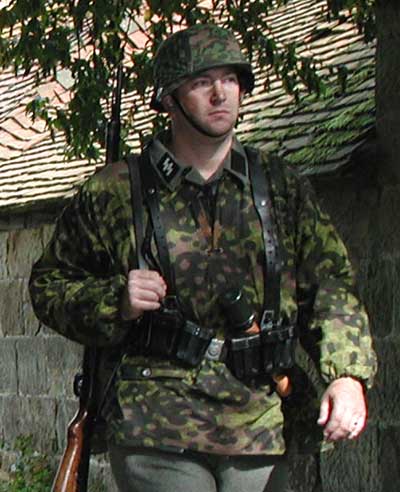 |
 |
The base colour for “spring” Oak Leaf is brown, so the first colour I apply to the undercoated figure is a 50:50 mixture of scorched brown and bleached bone. I tend to use bleached bone rather than white as it gives a dustier looking colour.
The next step is to add a dark green, made up of 2 parts catachan green to 1 part black, in the form of random shapes and dots.
Once the dark green has dried, mix up a light green using the same formula as that used for the Plane Tree base (50:50 catachan green/camo green). Add the light green to the dark green shapes and dots, being careful to leave a dark green border as seen in the step by step guide.
To finish the camouflage off add a few dark green dots to the light green shapes. There you have it: completed Oak Leaf camouflage.
As I mention both Plane Tree and Oak Leaf are reversible. I’ve only used the “spring” colours as the army I’m building is based around the time of the Normandy campaign. If you’re collecting a German army around the time of the battle of the bulge for example, then you’ll want to paint your camouflage in autumn colours. The best way to do this would be to use the guide above, but replace the colours with autumn hues.
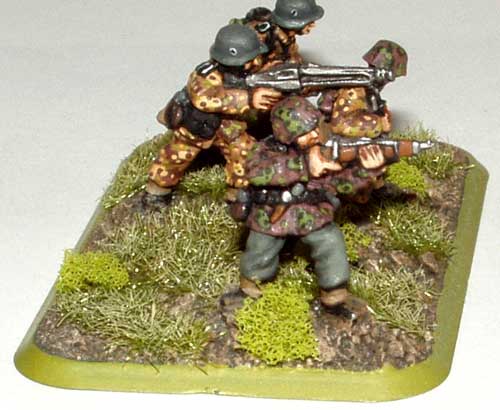
|
|
A search on the internet, your local library or book store should reward you with the colours you need to get the autumn look.
So what are you waiting for grab your miniatures, paint brush and paints …and get painting.
|
|
Simon Hooker (Sihook)
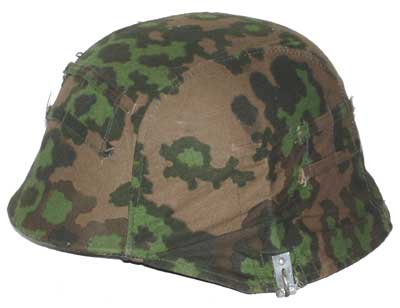
|
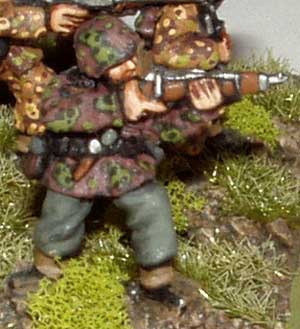 |
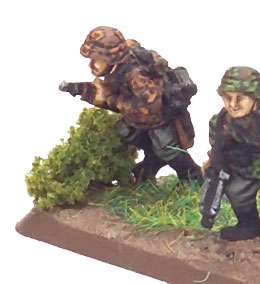 |
Additional painting tip from Evan
I’ve painted some autumn camo. I just used the same technique for the "spring" camo pattern as in Simon’s article above, but I swapped two of the colours for the "Spring" camo.
I kept the base brown, but swapped the Dark green for VP822 "Cam Black Brown" and the light green for VP929 "Light Brown" - and then I just followed Simon's instructions. This, worked really well for me.
Cheers,
~ Evan. |
|
|
|